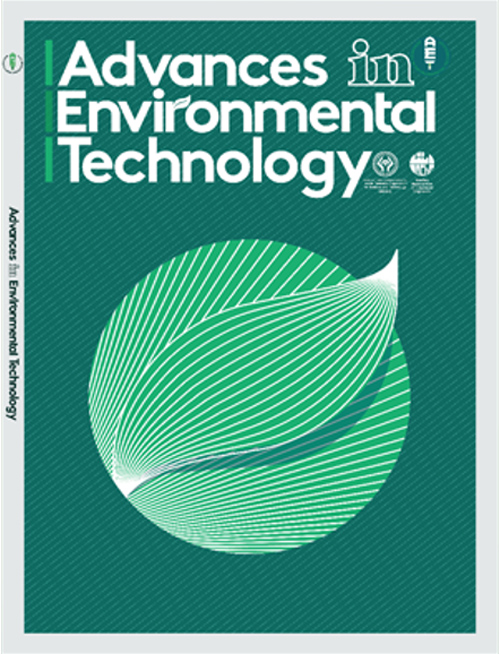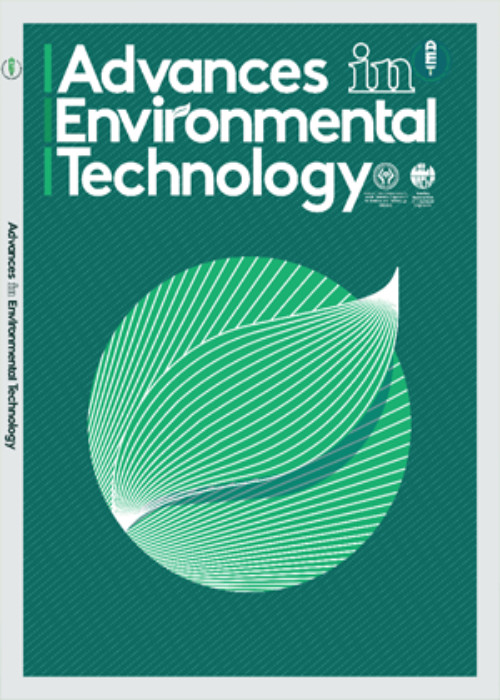فهرست مطالب

Advances in Environmental Technology
Volume:6 Issue: 4, Autumn 2020
- تاریخ انتشار: 1400/07/14
- تعداد عناوین: 6
-
-
Pages 175-185In the present study, graphene oxide (GO) was synthesized by the oxidation of graphite powder using the Hummers method. The GO was polymerized with poly methyl vinyl ketone (PMVK) and aniline (GO-MVK-ANI). It was utilized as the effective adsorbent towards the removal of Direct Red 81 (DR 81) in aqueous solutions. Response surface methodology (RSM) was applied for optimization and adsorption studies of Direct Red 81 removal using GO-MVK-ANI. According to the RSM results, the effects of the main parameters (the adsorbent dose, contact time, and pH) in dye removal efficiency were investigated. The R2 value of 99.99% indicated that the predictions of the RSM model were acceptable for Direct Red 81 adsorption onto the adsorbent. The regeneration of GO-MVK-ANI for the dye adsorption showed fine efficacy in up to seven times of recyclability. The RSM model was used to evaluate the respective minimum and maximum values of 56.52% and 99.90% for the removal efficiencies of Direct Red 81.Keywords: Direct Red 81, Graphene Oxide, regeneration, Response surface methodology, Optimization
-
Pages 195-209The present study assessed the impacts of seasonal variation on the atmospheric abundance of gaseous air pollutants (SO2, NO2, O3, CO) and particulates (PM2.5 and PM10) at Gazipur city. The air pollution data was collected from the study area using a Continuous Air Monitoring Station (CAMS) (CAMS-4, Gazipur) of DoE from October 2017 to September 2018. The highest concentrations of air pollutants were found in the winter (PM2.5=208 μg/m3, PM10=300 μg/m3, NO2=45.1 ppb, CO=3.91 ppm, O3=4.17 ppb) as opposed to those of the post-monsoon (PM2.5=133μg/m3, PM10=169 μg/m3, NO2=23.52 ppb, CO=2.25 ppm, O3=7.71 ppb), pre-monsoon (PM2.5=115 μg/m3, PM10=216 μg/m3, NO2=33.5 ppb, CO=1.75 ppm, O3=4.23 ppb), and monsoon (PM2.5=37.5 μg/m3, PM10=85.6 μg/m3, NO2=13.9 ppb, CO=0.84 ppm, O3=4.23 ppb). The highest concentration of five air pollutants (PM10, PM2.5, NO2, CO, O3)indicated that the higher pollutant load in the winter was associated with large-scale polluted air transported from the brick kiln at a distance of 5-7 km at the sampling site. The wind-rose data analysis indicated that most of the air during the winter season came to the sampling site from the northern part of the Gazipur district, from the brickfield zones. In contrast, a reverse relationship between the rainfall and atmospheric pollution, temperature, and atmospheric pollution load was observed during the pre-monsoon, monsoon, post-monsoon, and winter. This finding revealed that the lowest concentration of air pollutants during monsoon was associated with the washout effect of precipitation on atmospheric pollutants. A moderate correlation (R2=0.58) between CO and O3 pollutants during the study indicated their atmospheric origin by photochemical reactions was associated with volatile organic compounds (VOCs). PM2.5 showed a positive correlation with PM10 (R2=0.84), indicating that both PM2.5 and PM10 were produced from similar pathways of fossil fuel combustion by automobiles and industrial activities. Further, the air quality index (AQI) analysis showed unhealthy atmospheric conditions throughout the year for city dwellers around the study area.Keywords: Gaseous air pollutants, Particulates, O3, PM2.5, PM10, Wind rose, Air quality index
-
Pages 211-221Most riverine sediments have the high capability to adsorb and store heavy metal ions. In the present study, the adsorption capacity of the bed sediments collected from the Karaj River (Iran) were experimentally studied for cadmium ion adsorption. Multi-stage batch adsorption experiments were carried out for a constant sediment concentration of 20 g/L and different initial cadmium concentrations of 0.2, 0.5, 1, 10, 20, and 50 mg/L. The cadmium solutions with known concentrations were added to the bed sediment with the mean diameter of 0.53 mm in five stages to characterize the capacity of the sediments to adsorb cadmium. The batch adsorption experiments were conducted as both kinetics and equilibrium. The results showed that by adding cadmium ions to the sediment at each stage, the adsorption capacity was less than the previous stage, and for a cadmium concentration of 0.2 mg/L, the adsorption percent and the amount of adsorbed cadmium was reduced from 88 to 70% and 9 to 6.8 mg/kg, respectively. These changes decreased with increasing initial Cd concentrations. This process is useful for seasonal rivers in which a certain concentration of heavy metal pollution may occasionally flow over the bed.Keywords: Multi-Stage Adsorption, Riverbed Sediments, Cadmium, Kinetics
-
Multi-objective optimization of pyrolysis process of Prosopis farcta under non-isothermal conditionsPages 223-234Biochar is a recalcitrant substance that is produced through the pyrolysis process. The location of this study was Ahvaz in the central part of Khuzestan Province, Iran. To produce biochar, the biomass of Prosopis farcta was pyrolyzed at a temperature of 400°C to 800°C using the heating rate of 3 to 7 °C/min. Afterward, the electrical conductivity, cation exchange capacity, pH, specific surface area, and organic carbon of the biochar were recorded by employing standard methods. The pyrolysis factors such as temperature and heating rate were optimized using the Response Surface technique. Based on the results obtained, the temperature of the process was the most effective variable on the biochar characteristics. Besides, the temperature had a more substantial effect on the structure of the biochar than the heating rate. Also, the modeling results indicated that by enhancing the pyrolysis temperature, the electrical conductivity (EC)/pH of the produced biochar was enhanced mainly due to the concentration effect and reduction of acidic functional groups. With the strengthening of the pyrolysis temperature and heating rate, the organic carbon and specific surface area of the biochar were enhanced, while the cation exchange capacity decreased. According to the obtained results, the best model was found to be a quadratic model. In addition, the model for the EC parameter with the P-value of 0.0004 had the lowest effect compared with other studied pyrolysis factors. In general, the conditions of the pyrolysis process had a remarkable impact on the biochar characteristics; therefore, the effectiveness of biochar can be regarded as an organic amendment. To the best of the authors' knowledge, the present work is the first report assessing the effect of heating rate/ temperature on the biochar characteristics produced from Prosopis farcta.Keywords: Biochar, Prosopis farcta, waste management, heating rate, Response surface method
-
Pages 235-250Clean and safe drinking water is indispensable for maintaining the sound health of humans. The presence of toxic elements in drinking water may cause harmful health effects. In this study, the concentrations of heavy metals in the drinking water of different academic institutions of the Khulna City Corporation (KCC) were determined using an atomic absorption spectrophotometer (AAS). The human health risks were assessed based on estimated daily intake (EDI), target hazard quotient (THQ), hazardous index (HI), and target cancer risks (TCR). The presence of the investigated heavy metals was in the following ranges: Fe (18.5−861.6 µg/L), Mn (0.020−0.564 µg/L), Zn (8.8−96.1 µg/L), Cu (5.6−52.9 µg/L), and As (<0.5−105.3 µg/L). About 52% of the drinking water samples for Mn and 12% for As surpassed the Bangladesh standard (BDS) value of 50.0 µg/L. On the other hand, the As concentration in 88% of the samples exceeded the guideline value of the World Health Organization (WHO) (10.0 µg/L). The analysis of the Pearson’s correlation matrix (r) showed a positive correlation between Zn−Mn, Cu−Mn, Zn−Fe, Cu−Fe, and Fe−Mn at 0.01 levels and Zn−Cu and Fe−As at 0.05 levels, indicating the same pollution source. However, the THQ values of Zn, Cu, Fe, and Mn in all the studied samples were within the threshold risk limit (THQ < 1.0), and hence, safe from metal toxicity. But the THQ and HI of As for both adults and children and the TCR of As for adults in most of the investigated samples exceeded the maximum risk limit (THQ < 1.0; HI < 1.0; and TCR = 10−4), which revealed As could be a potential source of carcinogenic and non-carcinogenic health risks. Therefore, regular monitoring of heavy metals should be carried out to assure good quality drinking water for the students and academic staff.Keywords: Heavy metals, Drinking water, Health risks, Khulna city corporation, Bangladesh
-
Pages 251-265The electrocoagulation (EC) process is a novel approach in the mining industry, especially to recycle water in the dewatering system of a mineral processing plant. In this research, the electrocoagulation process was studied to remove the hardness and chloride ions from concentrate thickener overflow water under different operating conditions: retention time (5–15 min), initial pH (4–10), current density (41.6–166.6 A/m2) and electrode type (Fe, Fe-Al, Al). Four factors with three levels with the D-optimal response surface design were applied for optimization. As a result, the optimal situation for the electrocoagulation process was characterized by a retention time of 15 min, initial pH of 9.08, the current density of 139.59 A/m2, and electrode type Fe-Al. In this situation, the maximum removal efficiency of hardness (60.11%) and chloride (98.38%) were yielded with a desirability value of 0.989. These results illustrated the effectiveness of the EC process as an influence method for the removal of hardness and chloride in terms of separation.Keywords: Water Quality, Electrocoagulation, D-optimal experimental design, Modeling


